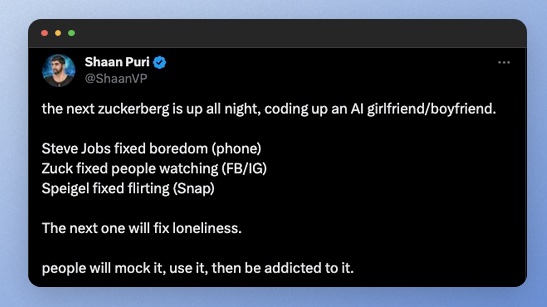
Loneliness is the biggest problem facing the next generation, and technology won’t fix it. Or shouldn’t try to fix it.
While tech isn’t the solution, entrepreneurs will build a solution anyway. They’ll make addictive products, like social media, and become billionaires. Instead of solving the problem, these solutions will only amplify it.
Let’s take a look back at history. The Nokia phones launched with the tagline “connecting the world.” It was easy to talk to people anytime, anywhere. It was awesome. We found our classmates and collegemates on Facebook, reconnected, and shared our lives. Yet the same tech products amplified loneliness. These tech products helped us communicate with people thousands of kilometers away; but they also made us lose the ability to understand people right next to us.
Likewise, tech products will play a significant role in addressing loneliness, but we should be careful about which solutions we build. While tech billionaires want to build addictive solutions and keep users within their walled gardens, technology will only solve part of the loneliness issue. The problem can’t be solved completely by it.
We should use technology to build memories in the physical world with people we care about – this is how we can fight loneliness. Here’s an example from my own life: I’ve connected with two people named Krishna Kumar (KK) and Sathyanand in the last few years. We met online and got to know each other via Zoom, WhatsApp, and LinkedIn. Eventually, we met in person and formed deeper connections. Our virtual interactions paved the way for meaningful relationships. I met Sathya in Gudalur with my family in a holiday home. We walked through the fields and played in the nearby river, creating lasting memories. In the same way, KK visited us in Panchkula. Together, we hiked a trail near a dam. Once again, we bonded over shared experiences and overcoming challenges, which fostered accomplishment, happiness, and connection.
Although technology will be part of the loneliness solution, it’s not the ultimate solution. If we rely solely on technology, we will make it worse. Our goal should be to use it to build lasting relationships and make memories with the people we love.
Comments
Indeed, you make a valid point. Relying on AI to alleviate loneliness could actually heighten anxiety.
This is already occurring in some instances. For example, on Instagram, there are profiles that are indistinguishable from real people but are actually AI. When boys in India engage with these profiles, the AI entities gradually shift the conversation to sexting. Eventually, they prompt the boys to make a payment to continue the conversation. While it’s not widespread yet, the groundwork for such interactions is being laid
When innovators looked at solving a problem..like connecting people over phone or social media, their intention wasn’t otherwise (to my knowledge). But once it became a big thing, probably the business management started to look at a way to monetize that.
Technology solution probably starts with solving the problem, but over a period it morphs into something that goes beyond what it was meant for. But as users of technology, we are supposed to be wary of how much we allow into our lives.
Hey Joseph Jude, thanks for the mention! Meeting you and your family was awesome. I totally relate to integrating virtual connections into meaningful real-life relationships.
Let me share an experience at my recent job. At work, I’m realizing that having an in-house team over remote staff is better. There’s something about being in the same physical space that fosters deeper understanding and connection. While virtual setups have perks, the richness of shared experiences in person is unparalleled.
Your article nails it—using tech as a bridge, not a replacement, for lasting connections. It’s about finding that balance between online and offline interactions to combat loneliness effectively.